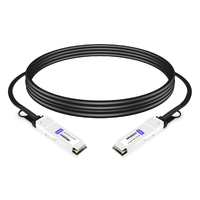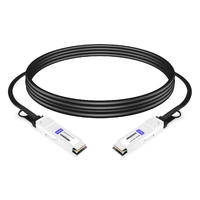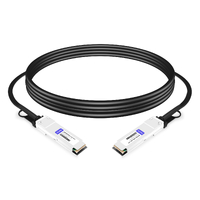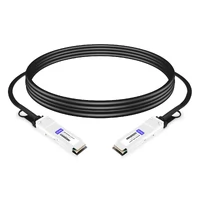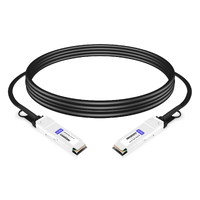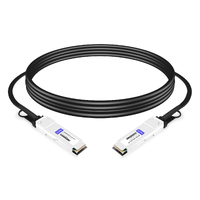Knowing how communication protocols work has become essential for professionals and hobbyists in the fast-changing world where high-speed connectivity is everything. This article is about the Quad Small Form-factor Pluggable (QSFP) 56 standard, which ensures strong data transmission across different networking environments. Given the growing need for bigger bandwidths, QSFP56 becomes an indispensable solution that helps data centers and network operators meet these demands efficiently. Technical specifications, benefits, and applications of QSFP56 technology will be discussed throughout this paper so that readers can have a holistic understanding of how it improves connectivity performance. This manual serves as a useful reference for those who would like to upgrade their current infrastructures or just want to know more about what lies ahead regarding network communications, with QSFP 56 at its core.
Table of Contents
ToggleWhat is a QSPF56 cable?

Key Features of 200g QSPF56
The 200G QSFP56 standard has many critical key features for faster networking:
- Wide Bandwidth: It is expected to reach 200 Gbps, which is much higher than its predecessors and can satisfy the needs of bandwidth-hungry applications.
- Single-Mode and Multi-Mode Operation: This interface supports both single-mode and multi-mode fiber optic cables, allowing users to choose the most suitable one for specific distances or applications.
- Better Heat Dissipation: QSFP56 modules have more sophisticated heat dissipation technologies that allow them to work under heavy loads without overheating or degrading performance.
- Cost-Effective Scalability: The new standard enables data centers to increase their capacity without changing too much hardware because it permits higher data rates over current infrastructures, thereby decreasing costs related to scalability.
- Backward Compatibility: These devices comply with previous versions of QSFP, so they can be used together with older systems without causing compatibility issues, which allows users to save money on upgrades.
Taken together, all these features make the 200G QSFP56 an adaptable and powerful solution that meets the diverse needs imposed by different industries and applications in contemporary networks.
Differences Between DAC Cables and Active Optical Cables
Direct Attach Copper (DAC) cables and Active Optical Cables (AOCs) are similar in terms of their usefulness for high-speed data transmission but different.
- Design: Usually, DAC cables are made of copper wires and designed to be shorter to connect devices directly. On the contrary, AOCs consist of electrical components and optical fibers that enable communication over longer distances.
- Range and Speed: DACs perform best within limited lengths, typically seven meters, using copper as a medium, thereby limiting their bandwidth. However, AOCs can cover up to one hundred meters or more, thus offering greater bandwidth suitable for data-intensive applications.
- Power Usage: In most cases, DAC cables consume less power since they are self-powered, unlike AOCs, which require electricity to run their electronics and optics, resulting in higher energy consumption.
- Cost: Because DAC cables are simpler and constructed with fewer technologies embedded, their cost is relatively low compared to advanced material-intensive AOC, which is priced at high levels because it contains more complex technology items used during fabrication.
- Flexibility and Weight: DAC cables tend to be heavier and less flexible than their AOC counterparts, which makes them difficult to install, especially in tight spaces such as data centers where multiple connections need to be made simultaneously.
To sum it up, whether one should use Direct Attach Copper or Active Optical Cable depends on the distance between connected devices, required bandwidth, and power availability/budget.
Applications in Data Centers and Other Industries
Data centers and numerous industries greatly need both Direct Attach Copper (DAC) cables and Active Optical Cables (AOCs). Within the same rack or adjacent racks, servers and switches are connected over short ranges using DAC cables because they are cheap and consume less power. This is most useful in environments that require dense cabling solutions. Lightweight design and higher bandwidth make AOCs perfect for long-distance connections, such as linking different floors or buildings within a campus where fast data transmission over extended distances can be achieved. Moreover, AOCs are increasingly used in video and multimedia applications, given their ability to meet large bandwidth requirements necessary for broadcasting, telecommunications, and high-performance computing scenarios.
How Does QSPF56 Work in Ethernet?

Compatibility with Ethernet Networks
The QSPF56, according to the IEEE 802.3bs standard, is a system used for optical communication in Ethernet networks, mainly in data centers. It can concurrently support data rates of up to 200G and 400G on various parallel fibers. The interface with QSPF56 is compatible with other Ethernet standards, so it can work well with old systems and new architectural designs. This allows enterprises to update their infrastructures without necessarily abandoning the former technologies since they can still interoperate with them. Furthermore, modules based on QSFP56 employ MTP/MPO connectors, which have widely used across many data centers, thereby making it easier for network operators looking forward to improving bandwidth capacities without having to do much rewiring or installing additional fibers. Due to its backward compatibility at different speeds and ability to function over short and long ranges, this becomes a versatile option for current Ethernet applications.
Setup and Configuration
Setting up QSPF56 modules to optimize Ethernet networks requires certain steps. The first is to verify that the current infrastructure can work with the MTP/MPO connector systems used by QSPF56 modules. Second, network operators must evaluate their cabling plan to ensure that they have implemented proper routing for parallel fibers, considering factors like distance and bandwidth requirements.
Once physical cabling is confirmed, it is necessary to handle the installation of the QSPF56 module into a compatible switch or router solution correctly in order not to damage optic fibers. Many manufacturers offer specific installation guides, including configuration settings for network equipment to recognize new high-speed modules. Also, it’s good practice to have an extensive testing phase using optical power meters and network testing tools that will help verify signal integrity and performance.
Afterward, monitoring tools can be useful in tracking performance post-installation to ensure timely addressing of any potential issues. Documentation should be kept for future reference purposes. This will help during troubleshooting and upgrades later on. Such a step-by-step method enables system administrators to tap into maximum bandwidth capacities offered by QSPF56 across their Ethernet-based network setups.
Performance and Bandwidth Considerations
It is important to evaluate several factors that determine the performance and bandwidth potential of QSPF56 modules on Ethernet networks. First, QSPF56 interfaces can support data rates of up to 400 gigabits per second (Gbps), which makes them suitable for use in high-demand settings. In addition, parallel optics are used effectively to achieve higher bandwidths while maintaining lower latency; thus, these are significant within data centers and enterprise networks.
Furthermore, one should pay great attention to cable management and routing since these directly affect signal integrity and attenuation. Depending on distances, using high-quality multimode or single-mode optical fibers will further improve the performance of QSPF56 connections according to application requirements. Network administrators may also need quality-of-service protocols that can be used for traffic prioritization to optimize network efficiency.
Regular monitoring and analysis of performance are advisable to detect abnormalities or bottlenecks and ensure that allocation matches operational needs within an organization. Addressing such considerations about performances and bandwidths will enable organizations to fully utilize QSPF56 modules in their network infrastructure.
How to Ensure Quality Testing Program for QSPF56?

Best Practices for Testing QSPF56 Cables
For better performance of QSPF56 cables, several best practices should be followed during testing.
- Use High-Quality Testing Equipment: For 400 Gbps applications, utilize certified and calibrated tools like Optical Time-Domain Reflectometers (OTDR) and power meters. These should be capable of measuring accurately the loss, reflectance, and bandwidths of optical fibers, among other capabilities.
- Perform Link Characterization: Check the whole link, including both ends of the cable and connectors; insertion loss test, return loss test as well as eye diagrams to evaluate signal integrity should be done.
- Follow Industry Standards and Protocols: Ensure that testing methods are in accordance with existing standards, such as ANSI/TIA-568 and IEEE 802.3 standards for optical fiber cabling, so that test results can be consistent and reliable.
- Record and Analyze Results: Keep detailed records of all tests performed together with their conditions and output. This data needs to be reviewed frequently while analyzing it so that any trends or patterns indicating potential problems affecting performance can be spotted.
- Schedule Maintenance Tests Regularly: Establish regular testing procedures, which will help monitor cable performance over time. This will detect early wear out, damage, or a drop in performance that may lead to network downtime, hence continuous operation reliability.
These guidelines will assist organizations in achieving expected levels of QSPF56 cable installations’ & connections’ performances in modern Ethernet networks.
Understanding Warranties and Return Policies
To appraise warranties and return policies of optic fiber products, attention should be directed towards their coverage terms as well as conditions required for returning them. Normally, most manufacturers offer guarantees against defects in materials and workmanship that last for one to many years, depending on the product or company. You need to read through warranty documentation so that you may understand what particular things are covered by it and any limitations or exclusions that might apply.
In relation to return policies; reputable suppliers usually give clients certain days within which they can bring back goods bought from them if not satisfied. This period often ranges between 30-90 days after the purchase has been made. For returns to be acceptable, the item must be in its original package together with all accessories intact and undamaged; also, proof of purchase is required. Customers should know how much restocking fee will be charged, who pays for shipping back cost incurred while sending the package, plus the steps followed when the retailer authorizes such a process so that the return can happen without delay. When these guarantees and policies are studied well by establishments, they will protect their investments in optical fiber technology wisely.
Avoiding Common Issues and Failures
To overcome recurrent errors and failures when installing optical fiber, it is important to follow certain rules. Firstly, there is a need for correct handling methods; stressing on fiber cables during installations causes micro-bending, which affects the performance negatively. SECONDLY, cleaning cable connectors correctly before installing can prevent contamination that interferes with signal integrity. Regular maintenance, including periodic inspection and testing, should be done so as to detect potential degradations in performance early enough. Also, environmental aspects like temperature and humidity should be controlled through monitoring to avoid damaging the fiber infrastructure. In conclusion, these steps will enable organizations to reduce downtime and keep their optical fiber networks at peak working conditions all the time.
Is There an Advantage of Using Nvidia Products with QSPF56 Connectivity?

Performance Benefits with Nvidia Networking Solutions
Nvidia products with QSPF56 connectivity are a great way to improve performance. They work especially well in applications that require a lot of data. The ability of QSPF56 to combine high bandwidth with low latency makes it possible for information to be transferred smoothly between different parts of the system. This is very important for artificial intelligence and machine learning systems, which need constant real-time data processing. Additionally, Nvidia networks are made so that they can be used together with their advanced GPU and AI frameworks, thereby guaranteeing faster speeds while managing resources better. Thus, this combination increases not only computational abilities but also efficiency within data centers as well. When companies use Nvidia’s technology, they get better scalability plus lower operational costs, thus making it ideal for any business organization looking forward to improving their network infrastructure.
Case Studies: Success Stories with Nvidia QSPF56
Nvidia successfully used QSPF56 connectivity in many organizations, demonstrating various benefits. For example, a major financial services company reported a 50% reduction in data processing time when it integrated Nvidia networking solutions with QSPF56 in its data center. This update not only increased efficiency but also enabled real-time analytics required for their fast-moving industry.
In another instance, a multinational tech firm leveraged Nvidia’s QSPF56 technology to support its AI and ML workloads. The outcomes were impressive – throughput went up significantly allowing the company to deal with much larger volumes of data thereby improving overall predictive capabilities.
Also, a well-known research establishment incorporated QSPF56 into their systems for high-performance computing simulations. The upgraded network infrastructure made simulations run 40% faster, directly affecting their research results and productivity rates. These accounts demonstrate how much change can be brought about by using Nvidia networks combined with QSPF56 connectivity while dealing with today’s business challenges.
What Are the Different Types of QSPF56 Cables?

Overview of QSPF56 Passive Direct Attach Copper Cables
QSPF56 Passive Direct Attach Copper (DAC) cables are made for fast data transmission in data centers and enterprise networking environments. These wires make use of copper and integrated connectors to create a cheap solution for connecting things within short distances, typically up to 5 meters. They work best with low latency high bandwidth applications and hence can be used with any networking equipment that has QSPF56 connectivity ability.
One advantage of these cables is their passiveness; they don’t need any external power supply, which simplifies the installation process, thus lowering energy consumption costs as well. Moreover, this feature ensures that the cable is strong enough so as not to break easily even under tough conditions found in most data centers; hence, it should give reliable performance all the time. Generally speaking, QSPF56 DAC cables suit places where there is a need for high-speed interconnections like those used in high-frequency trading systems or when people want to enhance network efficiency through data replication, etc.
Understanding Active Optical Cable Technology
Active Optical Cable (AOC) technology is a big step forward when it comes to fast connectivity in data centers and enterprise networks. It does this by combining optical fibers with electrical connectors, creating a way for data to be sent long distances at higher speeds—usually from 10 meters up to a few hundred meters—than can be achieved with traditional copper cables. Within the cable are transceivers that change electrical signals into light pulses, thus enabling quick data transfer where low latency and high performance are needed.
The weightlessness of AOCs makes them easy to route through equipment racks so that there’s less mess and better airflow in data centers. Additionally, being immune from electromagnetic interference (EMI) means they work well in places where there’s lots of electronic noise around, such as data-intensive applications where signal integrity must always remain intact. These qualities, combined with their lack of power consumption, make active optical cables ideal for use in energy-conscious environments connected by modern networks designed for maximum performance needs.
Choosing Between 1M, 2M, and Other Length Options
While evaluating the appropriate length of DAC or AOC cables, it is important to consider the physical design of your data center and the network performance requirements. Normally, one meter and two meters are popular options with different uses. For instance, a 1M length is enough for short connections between neighboring devices because it reduces extra cables and enhances signal integrity. On the other hand, a 2M cable offers more flexibility at slightly longer distances where equipment might be spaced apart farther but still work well together.
Moreover, longer than these lengths exist so that you can have them when dealing with more complicated setups that need to connect over greater areas or within larger configurations. However, the extended cables should be considered against possible loss of signals, especially in copper solutions where there may be delay due to distance or even efficiency problems in general. In conclusion, choose what best suits your system among these alternatives based on architectural milieu and functional demands while considering performance optimization and security requirements. Always refer back to the manufacturer specifications of your devices for compatibility assurance and to maintain high levels of network integrity.
Reference Sources
Frequently Asked Questions (FAQs)
Q: What is QSFP56, and why is it important?
A: QSFP56 is a high-speed connectivity module that supports 200G Ethernet and Infiniband HDR. It upgrades from QSFP28 and enables data centers to improve network performance and scalability.
Q: In what ways does a 200G QSFP56 module differ from the previous ones?
A: The data rate of a 200G QSFP56 module is twice as fast as that of a QSFP28, which means it can provide higher bandwidth, thus enhancing network efficiency. This makes it ideal for environments where quick transfer speed coupled with low latency is needed, such as HPCs or DCs.
Q: What separates a QSFP56 passive direct attach copper cable from an active optical cable?
A: For concise links (typically within racks), cheap solutions are available in the form of QSFP56 passive direct-attach copper cables, while active optical cables are used over longer distances because they offer better performance through optical fiber.
Q: Are Mellanox LinkX DAC cables compatible with QSFP56 ports?
A: Yes, Mellanox LinkX DAC cables can be used together with QSFP56 ports, providing the high-speed connections commonly required by Data Centers supporting Infiniband HDR or 200G Ethernet connectivity.
Q: Why should low power consumption be considered when using QSFP56 modules?
A: Low power consumption in these devices lowers operational costs and improves energy efficiency, enabling DCs to minimize their carbon footprint while improving overall performance.
Q: What is LSZH, and why is it essential to QSFP56 cables?
A: LSZH stands for Low Smoke Zero Halogen, a type of cable jacket material that reduces smoke and toxic fumes in the event of a fire. Therefore, QSFP56 cables with LSZH jackets are safe in closed or populated areas.
Q: In what way do QSFP56 DAC cables primarily enable high-speed connectivity?
A: They mainly allow for high-speed connectivity because they offer an inexpensive yet dependable way of bridging neighboring racks within data centers while ensuring low latency and high throughput; this applies specifically to 200G QSFP56 DAC twinax cables.
Q: Is there a notable price difference between QSFP56 passive copper cables and QSFP56 active optical cables?
A: Absolutely. Normally, QSFP56 passive copper cables are more cost-effective than their active optical counterparts. Copper ones work best for short distances, while optic ones are needed for longer distances and superior performance.
Q: How does a lifetime warranty affect the choice of QSFP56 modules?
A: A lifetime warranty gives confidence in long-term reliability and support. It covers you against any defects or failures, potentially reducing replacement/maintenance costs throughout the module’s life span.
Q: What should be considered when selecting a QSFP56 cable solution?
A: Some things to consider include distance requirements, power consumption, data rate needs, compatibility with existing hardware, and LSZH safety requirements. You should also consider whether a cost-effective passive copper or high-performance active optical cable would be more suitable for your specific application.
Related Products:
-
 QSFP56-200G-PC50CM 0.5m (1.6ft) 200G QSFP56 to QSFP56 PAM4 Passive Direct Attach Copper Twinax Cable
$45.00
QSFP56-200G-PC50CM 0.5m (1.6ft) 200G QSFP56 to QSFP56 PAM4 Passive Direct Attach Copper Twinax Cable
$45.00
-
 QSFP56-200G-PC1M 1m (3ft) 200G QSFP56 to QSFP56 PAM4 Passive Direct Attach Copper Twinax Cable
$50.00
QSFP56-200G-PC1M 1m (3ft) 200G QSFP56 to QSFP56 PAM4 Passive Direct Attach Copper Twinax Cable
$50.00
-
 QSFP56-200G-PC1.5M 1.5m (5ft) 200G QSFP56 to QSFP56 PAM4 Passive Direct Attach Copper Twinax Cable
$60.00
QSFP56-200G-PC1.5M 1.5m (5ft) 200G QSFP56 to QSFP56 PAM4 Passive Direct Attach Copper Twinax Cable
$60.00
-
 QSFP56-200G-PC2M 2m (7ft) 200G QSFP56 to QSFP56 PAM4 Passive Direct Attach Copper Twinax Cable
$65.00
QSFP56-200G-PC2M 2m (7ft) 200G QSFP56 to QSFP56 PAM4 Passive Direct Attach Copper Twinax Cable
$65.00
-
 Arista Networks C-Q200-Q200-3M Compatible 3m (10ft) 200G QSFP56 to QSFP56 PAM4 Passive Direct Attach Copper Twinax Cable
$80.00
Arista Networks C-Q200-Q200-3M Compatible 3m (10ft) 200G QSFP56 to QSFP56 PAM4 Passive Direct Attach Copper Twinax Cable
$80.00
-
 QSFP56-200G-PC2.5M 2.5m (8ft) 200G QSFP56 to QSFP56 PAM4 Passive Direct Attach Copper Twinax Cable
$75.00
QSFP56-200G-PC2.5M 2.5m (8ft) 200G QSFP56 to QSFP56 PAM4 Passive Direct Attach Copper Twinax Cable
$75.00

